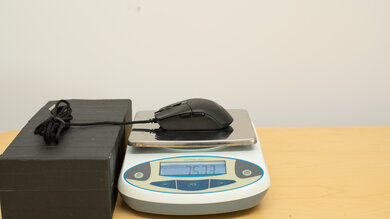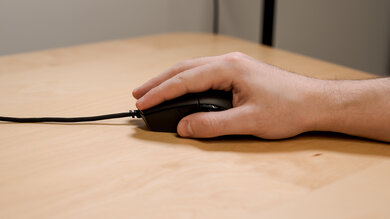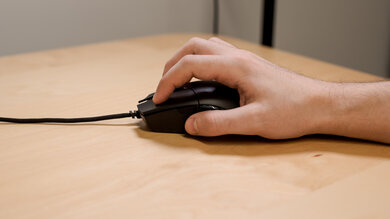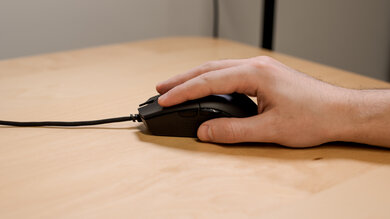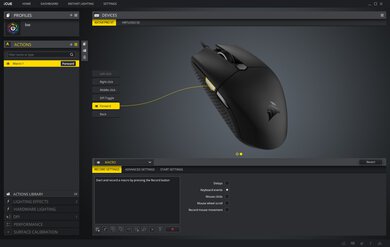The Corsair KATAR PRO XT is a lightweight, ambidextrous mouse with two buttons on its left side. It looks physically identical to Corsair KATAR PRO Wireless, except it's a wired mouse and has RGB strips on its scroll wheel. It feels very well-built and comfortable, and its small size is best suited for a claw or fingertip grip. It has a low click latency, a low lift-off distance, and a very wide CPI range that can be precisely adjusted in increments of 1. Unfortunately, the sensor is very inconsistent, and it undershoots the set CPI more when moving fast than when moving slow.
Our Verdict
The Corsair KATAR PRO XT is decent for office use. While it doesn't have an ergonomic shape, this very well-built mouse should still feel very comfortable for most hand sizes using a claw or fingertip grip. Unfortunately, its scroll wheel doesn't have L/R tilt buttons, and it can't be unlocked for infinite scrolling. Also, the mouse isn't wireless, and some people might find the cable cumbersome.
-
Feels very well-built.
-
Customization software available on Windows and macOS.
-
Two programmable side buttons.
-
Not as ergonomic as dedicated office mice.
-
Wired-only design.
-
No free wheel or L/R tilt buttons.
The Corsair KATAR PRO XT is great for FPS gaming. It feels very well-built, and it's best suited for a claw or fingertip grip. Despite not having a honeycomb design, this mouse is quite light. The click latency is low, and it should feel responsive for most people. Unfortunately, its sensor is very inconsistent, and it undershoots the set CPI when moving fast more than when moving slow.
-
Feels very well-built.
-
Customization software available on Windows and macOS.
-
Low click latency.
-
CPI can be adjusted in increments of one.
-
Sensor is inconsistent between fast and slow movements.
The Corsair KATAR PRO XT is very good for MMO gaming, although it doesn't have nearly as many side buttons as dedicated MMO mice. It has a low click latency and a wide CPI range that can be adjusted very precisely in increments of 1. It feels very well-built and comfortable, but people with larger hands may struggle with a palm grip. Unfortunately, its sensor is very inconsistent, and it undershoots the set CPI more when moving fast more than when moving slow.
-
Feels very well-built.
-
Customization software available on Windows and macOS.
-
Low click latency.
-
CPI can be adjusted in increments of one.
-
Doesn't have as many buttons as dedicated MMO mice.
-
Sensor is inconsistent between fast and slow movements.
The Corsair KATAR PRO XT is a great ultra-light gaming mouse. It's quite lightweight, feels very well-built, and is suitable for most hand sizes using a claw or fingertip grip. It has a low click latency and a high maximum polling rate. The paracord-like cable is fairly flexible, although it does retain some kinks.
-
Feels very well-built.
-
Low click latency.
-
Quite light.
-
CPI can be adjusted in increments of one.
-
Sensor is inconsistent between fast and slow movements.
The Corsair KATAR PRO XT isn't designed for travel. This wired mouse won't be ideal while working in tight spaces like a bus or plane, and it isn't very portable.
-
Feels very well-built.
-
Wired-only design.
-
Bulky design may not fit in all laptop cases.
- 7.0 Office/Multimedia
- 8.4 Video Games (FPS)
- 8.0 Video Games (MMO)
- 8.2 Ultra-Light Gaming
- 5.4 Travel
Changelog
- Updated Dec 01, 2022: We've converted this review to Test Bench 1.2. This update simplifies our Weight test and expands on our CPI test from Test Bench 1.1, resulting in changes to test results in both sections. For more details, you can see our complete changelog here.
- Updated Nov 17, 2022: We've converted this review to Test Bench 1.1. This update revamps our Click Latency test and results in changes to test results. For more details, you can see our full changelog here.
- Updated Apr 29, 2021: Fixed a calculation error with the CPI Variation.
- Updated Mar 26, 2021: Review published.
- Updated Mar 23, 2021: Early access published.
Check Price
Differences Between Sizes And Variants
The Corsair KATAR PRO XT has no variants and it's only available in black. You can see the label of our unit here.
Compared To Other Mice
The Corsair KATAR PRO XT is a great gaming mouse that's quite light, although it isn't as light as some dedicated ultra-light gaming mice. It has a very wide CPI range that, unlike many other gaming mice, you can adjust very precisely by increments of 1. Unfortunately, the sensor is a bit inconsistent as it tends to undershoot the set CPI more when moving the mouse fast than when moving it slowly. For other options, see our recommendations for the best gaming mouse, the best FPS mouse, and the best wired mouse.
The Corsair KATAR PRO XT is better for gaming than the Razer DeathAdder Essential. The Corsair has a significantly lighter weight and a more flexible, paracord-like cable. Performance-wise, it has a much wider CPI range, a CPI you can adjust in increments of one, a lower lift-off distance, and a lower click latency; however, its sensor is very inconsistent. On the other hand, the Razer has a right-handed shape and lacks the Corsair's CPI switching button, but you can assign a HyperShift button to give you another customization layer. People with small hands using a claw or fingertip grip may prefer the Corsair's smaller size, and people with larger hands using a palm or claw grip may prefer the Razer.
The Corsair KATAR PRO XT and the Logitech G203 Prodigy are both great gaming mice with a similar ambidextrous, egg-shaped design. The Corsair has a more flexible paracord-like cable and a much wider CPI range that can be adjusted very precisely in increments of 1. On the other hand, while the Logitech's CPI range isn't as wide or adjustable, its sensor is significantly more consistent. Also, it has more programmable inputs, and you can set a profile switching button. The click latency is also lower, although not by a significant amount.
The Corsair KATAR PRO XT is better than the Corsair KATAR PRO Wireless, but the PRO Wireless is a better choice if you prefer not having a cord. Otherwise, the PRO XT has a wider CPI range that can be adjusted very precisely in increments of 1, and it has a significantly lower minimum lift-off distance. On the other hand, the PRO Wireless' sensor has zero CPI variation, and its click latency is much lower despite being wireless.
The Logitech G PRO HERO and the Corsair KATAR PRO XT are both great wired gaming mice. If you're a fan of light mice, the Corsair is a better choice since it weighs much less than the Logitech. The Corsair also has a much more precisely adjustable CPI range. On the other hand, the Logitech has a much more consistent sensor, more programmable buttons, and a much lower click latency.
The Razer Viper Mini and the Corsair KATAR PRO XT are both ambidextrous, wired gaming mice. The Razer is a better choice if you prefer having an ultra-light mouse since it weighs quite a bit less than the Corsair. The Razer also has a much lower click latency, many more programmable buttons, and smoother-gliding feet. However, the Corsair has a much lower lift-off distance, a more precisely adjustable CPI range, and its customization software is available on macOS.
The SteelSeries Rival 3 and the Corsair KATAR PRO XT are great wired gaming mice with a similar ambidextrous shape. The Corsair's paracord-like cable feels more flexible than the SteelSeries's rubber cable, but its mouse feet don't glide as well. The Corsair has a more precisely adjustable CPI range and a much lower list-off distance, but its sensor isn't as consistent as the SteelSeries's.
Test Results
The Corsair KATAR PRO XT is an all-matte black mouse, with glossy accents on the side buttons, CPI button, and the area surrounding the scroll wheel. It has an ambidextrous design with two buttons on its left side. The sides are slightly textured to help with grip. It has the same look as the Corsair KATAR PRO Wireless, but it has a full RGB zone in its scroll wheel.
It feels excellently built. The body feels solid, with no flex or loose parts. Buttons don't squeak when pressed, and there are no rattling sounds when shaking the mouse. Since it doesn't have a removable back cover to store a battery as the Corsair KATAR PRO Wireless does, the Corsair KATAR Pro XT feels much better built.
The Corsair KATAR PRO XT is quite light, although it isn't as light as some ultra-light mice like the GLORIOUS Model D and the HyperX Pulsefire Haste.
It has an ambidextrous shape like the Corsair KATAR PRO Wireless. Due to its short body, it's best suited for a claw or fingertip grip, although people with small or medium hands may also feel comfortable with a palm grip. The buttons and scroll wheel feel well-placed and should be easy to reach. While the sides of the mouse are textured, they don't provide much grip.
It's suitable for people with small and medium hands when used with a palm grip. However, people with large or extra-large hands may struggle to comfortably reach the scroll wheel and side buttons. If you're looking for a similar gaming mouse that's well-suited for a palm grip regardless of hand size, check out the BenQ ZOWIE FK1-B. If you're interested in a lightweight, wireless gaming mouse but with an ergonomic right-handed shape, check out the ROCCAT Kone Pro Air.
While Corsair advertises the cable as a paracord, the wire feels too stiff and kinky to be a true paracord. Nonetheless, it's fairly flexible, but it retains some kinks from packaging.
The Corsair KATAR PRO XT has a very good click latency. While it's slightly higher than some other options, it should feel responsive enough for most people.
Update 04/29/2021: We fixed an error with the CPI Variation. The correct value is -20%. We updated the review accordingly.
The Corsair KATAR PRO XT has a very wide CPI range that can be adjusted very precisely in increments of 1. The minimum lift-off distance is very low, so the sensor shouldn't track your movements when you reposition your mouse. You can choose between four polling rates: 125Hz, 250Hz, 500Hz, and 1000Hz. Unfortunately, the sensor is very inconsistent and tends to undershoot the CPI more when moving fast than when moving slow.
The Corsair KATAR PRO XT's scroll wheel is a standard incremented wheel with a pronounced step definition. It has a textured rubber strip around it that feels grippy. There's no L/R tilt, and it can't be unlocked for infinite scrolling.
The Corsair iCUE is compatible with both Windows and macOS, and you can customize every aspect of the mouse. However, the task of assigning macros and saving to the on-board memory isn't very user-friendly.
Comments
Corsair KATAR PRO XT: Main Discussion
Let us know why you want us to review the product here, or encourage others to vote for this product.






